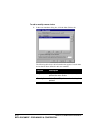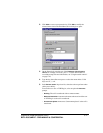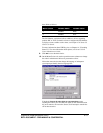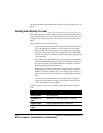
9-18 STRATA CS ADMINISTRATOR MANUAL
BETA DOCUMENT - PRELIMINARY & CONFIDENTIAL
For more information about deleting items in Strata CS, see “Deleting items” on
page 2-9.
Routing calls directly to a user ___________________________
This method dedicates a trunk to a single user. All incoming calls on the trunk are
sent to that user. If the user is busy or doesn’t answer, the calls follow the user’s
routing list. The only outgoing calls on the trunk are those placed by the user’s
phone.
With this option you can do the following:
n Send incoming calls on the trunk to a live operator, who then transfers the
calls to the appropriate destination. You can do this on all your trunks.
n Send incoming calls on the trunk to a user, giving that user a dedicated
private line. If your phone lines do not support direct inward dial (DID),
this is the only way to let callers dial a user directly, without going through
an auto attendant.
n If your phone lines support DID, give a user a direct-dial phone number
using that method instead, without sacrificing a trunk. However, there can
be users who require an actual dedicated line, for example, to generate
their own outgoing caller ID information.
n Route calls on a trunk to a workgroup and ring the workgroup’s phones
simultaneously. By doing so you can give a department its own phone
number. To make all incoming calls to your company ring everybody’s
phone at once, route your main number to a workgroup that contains all
users.
n Give an automatic call distribution (ACD) workgroup its own phone
number by routing calls on a trunk to a workgroup (see Strata CS Call
Center Administrator Guide for details).
To route a trunk to a user (or to a workgroup as described earlier), modify the
trunk.
Trunk type To modify trunk, open this dialog box
Analog trunk Trunk dialog box
Robbed Bit T1
span
Robbed Bit T1 Span dialog box, Trunks tab
Internet span Internet Span dialog box, General tab
ISDN/CAS T1/E1
span
ISDN/CAS T1/E1 Span dialog box, Trunks tab


















